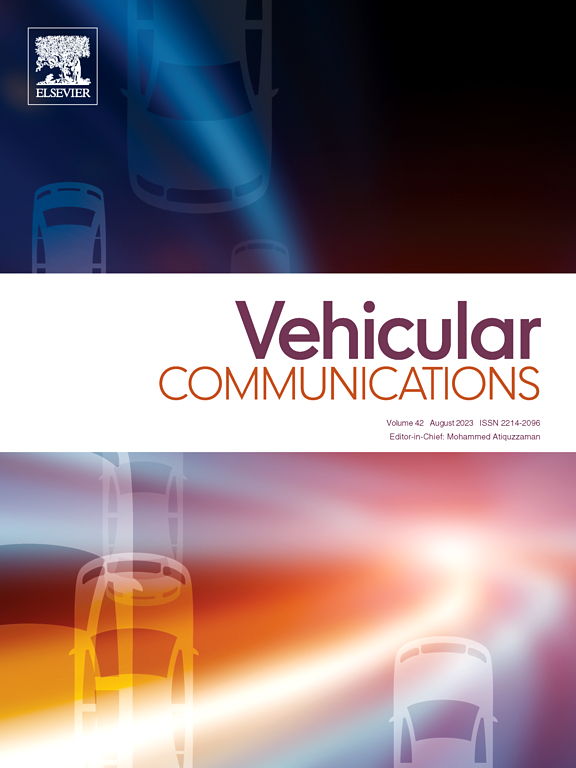基于无人机位置估计的毫米波ntn发射功率优化分配方案
IF 6.5
2区 计算机科学
Q1 TELECOMMUNICATIONS
引用次数: 0
摘要
非地面网络(NTNs)通常由配备有产生大量数据的多个传感器的无人机群组成,需要与网关进行实时通信以进行进一步处理。因此,工作在24 GHz以上的毫米波(mmWave)通信技术成为实现高速无人机群通信的合适解决方案。然而,毫米波通信技术使用基于多个天线的定向波束形成来提高覆盖范围,这会导致更高的功耗和频繁的波束训练开销,影响群的续航能力。为了解决这个问题,我们提出了一种新的最优发射功率分配方案,通过减少波束训练开销来提高群耐力和吞吐量。首先,该方案在发射无人机上使用卡尔曼滤波器(本文但不限于)来估计接收无人机的实时位置。利用估计位置计算路径损耗,选择满足接收无人机所需接收信号功率阈值所需的最优发射功率电平。为了减少无人机位置估计误差造成的中断,该方案还通过在估计位置周围加入额外的缓冲距离来调整发射功率水平,从而在最小的发射功率增加下提高可靠性。性能分析表明,在饱和交通条件下,该方案在提高吞吐量的同时实现了99%以上的平均可靠性和49.4%的节能,从而确立了其在移动无人机群中的有效性。此外,该方案还与文献中存在的三种流行机制进行了比较:1)使用恒定发射功率的基线方法,2)基于深度学习(长短期记忆,LSTM)的发射功率分配,以及3)使用α - β - γ滤波器接收无人机位置估计的功率分配。性能比较表明,该方案在节能、可靠性、吞吐量和计算复杂度等方面具有较好的性能。本文章由计算机程序翻译,如有差异,请以英文原文为准。
An optimal transmit power allocation scheme using UAV position estimation in MmWave NTNs
Non-terrestrial networks (NTNs) typically consist of UAV swarms equipped with multiple sensors that generate massive data, requiring real-time communication to a gateway for further processing. Hence, millimeter-wave (mmWave) communication technologies operating above 24 GHz emerge as a suitable solution for enabling high-speed intra-UAV swarm communication. However, mmWave communication technologies use multiple antenna-based directional beamforming for improved coverage, which leads to higher power consumption and frequent beam training overhead, affecting swarm endurance. To address this, we propose a novel optimal transmit power allocation scheme that enhances swarm endurance and improves throughput by reducing beam training overhead. Firstly, the proposed scheme uses the Kalman filter (in this paper, but not limited to) at the transmitting UAV to estimate the real-time position of the receiving UAV. The estimated position is utilized to calculate path loss and select the optimal transmit power level needed to meet the required received signal power threshold at the receiving UAV. To reduce outages from errors in UAV position estimation, the proposed scheme also adjusts the transmit power level by incorporating an additional buffer distance around the estimated position, thereby enhancing reliability with a minimal increase in transmit power. The performance analysis shows that the proposed scheme achieves an average reliability of more than 99% and power savings of up to 49.4% while increasing the throughput under saturated traffic conditions, thus establishing its effectiveness in mobile UAV swarms. Also, the proposed scheme is compared with three popular mechanisms existing in the literature: 1) baseline approach where constant transmit power is utilized, 2) deep learning (long short-term memory, LSTM) based transmit power allocation, and 3) power allocation using filter for receiving UAV position estimation. The performance comparison shows that the proposed scheme offers superior performance in terms of power savings, reliability, throughput, and computational complexity.
求助全文
通过发布文献求助,成功后即可免费获取论文全文。
去求助
来源期刊

Vehicular Communications
Engineering-Electrical and Electronic Engineering
CiteScore
12.70
自引率
10.40%
发文量
88
审稿时长
62 days
期刊介绍:
Vehicular communications is a growing area of communications between vehicles and including roadside communication infrastructure. Advances in wireless communications are making possible sharing of information through real time communications between vehicles and infrastructure. This has led to applications to increase safety of vehicles and communication between passengers and the Internet. Standardization efforts on vehicular communication are also underway to make vehicular transportation safer, greener and easier.
The aim of the journal is to publish high quality peer–reviewed papers in the area of vehicular communications. The scope encompasses all types of communications involving vehicles, including vehicle–to–vehicle and vehicle–to–infrastructure. The scope includes (but not limited to) the following topics related to vehicular communications:
Vehicle to vehicle and vehicle to infrastructure communications
Channel modelling, modulating and coding
Congestion Control and scalability issues
Protocol design, testing and verification
Routing in vehicular networks
Security issues and countermeasures
Deployment and field testing
Reducing energy consumption and enhancing safety of vehicles
Wireless in–car networks
Data collection and dissemination methods
Mobility and handover issues
Safety and driver assistance applications
UAV
Underwater communications
Autonomous cooperative driving
Social networks
Internet of vehicles
Standardization of protocols.
 求助内容:
求助内容: 应助结果提醒方式:
应助结果提醒方式:


